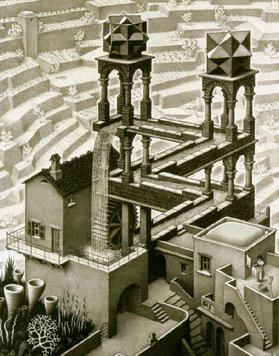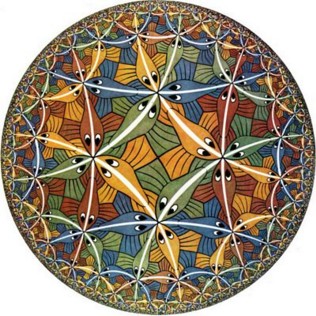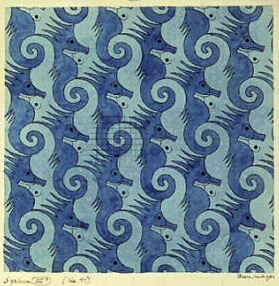 I came across the video below the other day. It's designed around the image at the right as a physical demonstration of M. C. Escher's Waterfall. Escher always produced fascinating graphical representations of the impossible.
I came across the video below the other day. It's designed around the image at the right as a physical demonstration of M. C. Escher's Waterfall. Escher always produced fascinating graphical representations of the impossible.As a teenager I was fascinated by the images he created and kept prints of this and other Escher works in my bedroom. To this day I still have books with Escher prints.
Escher, a Dutch graphic artist, lived from 1898 to 1972. Although he started as purely an artist Escher began to incorporate mathematical concepts into his art as the years progressed.
His works included other "impossible objects" such as the Necker cube and the Penrose triangle.
The Penrose triangle link above provides some insight as to how physical representations of these object can be constructed. Its important to note that the illusion typically only works from one very precise location, i.e., any other perspective will reveal how the illusion is made.
Other interesting impossible objects include the devil's tuning fork and the Penrose stairs.
Occasionally someone will work hard, like the guy in this video, to duplicate this illusion in physical reality:
Escher adjusts the perspective of the viewer in his works in order to create the illusion. As to how this guy created this video - I really have no idea but I am quite certain there are no hidden pipes or other trickery of that type involved.
My guess is that the perspective of the camera is critical to what you see and if the camera were moved even a tiny bit what you would see would not be as it appear here.
Other examples of "physical impossible objects" include this (warning: bad language) and this.
Escher also created many graphics of tessellations. For example Circle Limit III:
Notice how each type of cell (as divided by the white lines) is similar. Another example (Heaven and Hell):
Here there are no "lines" separating the elements. In this case the "angles" and "devils" inter-mesh perfectly to create the tessellation. The circular tessellations are known as hyperbolic. Escher also created linear X/Y tessellations such as this:
In any case the impossible objects are a lot of fun...



No comments:
Post a Comment